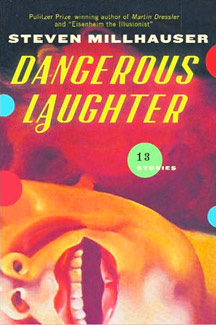Review of Dangerous Laughter by Steven Millhauser
07.03.08
 If an author is lucky, his work lives on in ruins. Posterity preserves a few pullquotes to stand for the whole; moviemakers, arrivistes that they are, curate and bequeath these galleries with bullying benevolence. For instance, Steven Millhauser is “the author of ‘Eisenheim the Illusionist’,” from whence comes Neil Burger’s The Illusionist, its pulsating romance, its percolating political unrest and its Shocking Twist! Millhauser’s story has but the faintest murmurings of love and politics: Eisenheim, whose act climaxes with his own permanent disappearance, seems to exist only onstage. (“In 1898 he opened his own theater in Vienna, called simply Eisenheimhaus, or The House of Eisenheim, as if that were his real home and all other dwellings illusory.”)
If an author is lucky, his work lives on in ruins. Posterity preserves a few pullquotes to stand for the whole; moviemakers, arrivistes that they are, curate and bequeath these galleries with bullying benevolence. For instance, Steven Millhauser is “the author of ‘Eisenheim the Illusionist’,” from whence comes Neil Burger’s The Illusionist, its pulsating romance, its percolating political unrest and its Shocking Twist! Millhauser’s story has but the faintest murmurings of love and politics: Eisenheim, whose act climaxes with his own permanent disappearance, seems to exist only onstage. (“In 1898 he opened his own theater in Vienna, called simply Eisenheimhaus, or The House of Eisenheim, as if that were his real home and all other dwellings illusory.”)
As for Millhauser, his world extends only to the margins of the page. His 1972 debut novel Edwin Mullhouse: The Life and Death of an American Writer, 1943-1954 by Jeffrey Cartwright is a biography of a literary genius who died on his 11th birthday, as told by his next-door neighbor and playmate. His art is a “shaping frame” for the world. His death, following the completion of his nigh-unread opus Cartoons, is another frame, effectively containing his existence within the space of his book. “[T]he thingness of speech,” is key to Edwin’s work, we’re told (via narration that’s less unreliable than a how-was-school-today tall tale), so that speech isn’t an armless statue in a museum with a plaque to fill in the context, but an indivisible and all-encompassing entity in itself. “In the beginning was silence, womb of all words which all words seek… Edwin once agreed with me that the ideal order of words on a page creates in the ideal reader an ideal silence… ” It’s a bit like Plato’s Cave, ideal forms flickering across the walls of our memory, waiting to be held in place by the magic combination of syllables.
Millhauser’s syntax is ornate, his descriptions precise and exhaustive; many of his passages are inventory storehouses of nostalgic imagery: suburban living rooms, elementary school classrooms, amusement parks, candy stores. Flicking a Viewfinder through scenes from postwar Americana, and childhood, Edwin Mullhouse’s exactitude strives to recapture “the thingness” of social and personal memory. Language is both vehicle for and hindrance to the totality of experience: “[Edwin] became obsessed by the notion that there was a name for everything; perhaps he felt that the world contained a finite number of things and to learn the names of all of them was to define the universe.”
Dangerous Laughter, Millhauser’s new short story collection, considers art of all sorts as a kind of vocabulary: if we knew how to make from it the perfect “shaping frame,” we might contain infinity. The book’s first frame is perhaps its most unlikely. Opener “Cat ‘n’ Mouse”—like the stand-alone chapter that opens the earlier novel’s second section—is a scene-by-scene narration of a cartoon battle between a scheming, bumbling predator and its cunning prey, who “stands flat against the doorjamb, facing the living room, his eyes darting left and right. One leg tiptoes delicately around the jamb. His stretched body snaps after it like a rubber band.” See it? It’s a matter of finding “the ideal order of words” to describe the cartoon tropes, and thus conjuring in the ideal reader their own warm memories of ideal Saturday mornings. Finally, though, the Tom and Jerry grammar leads, like Eisenheim’s music hall trickery, to an absolute conclusion: the mouse takes his handkerchief and rubs out first the cat, then himself. That’s all, folks.
Following this “Opening Cartoon,” each of the book’s three subsequent sections, comprised of four stories each, depict the construction of world maps, expanding (as in the Borges and Bioy-Casares parable) towards a scale of 1:1. The tales in “Vanishing Acts” tell not of Hapsburg Vienna but of townships whose perma-50s iconography (maple trees, girls in rolled-up jeans, driveway basketball) glows like Edwin Mullhouse’s Crayola-green suburban lawns. For Millhauser, anywhere might provide a stage grand enough, a frame expansive enough, a page perfect enough, to contain everything. The section ends with “History of a Disturbance,” whose narrator finds speech inadequate. “Words interfere with the world,” he says:
I saw a whitish thing on the kitchen table. In that instant the whitishness on the white table was mysterious, ungraspable. It seemed to spill onto the table like a fluid… A moment later everything changed. I recognized a cup, a simple white cup. The word pressed it into shape, severed it—as if with the blow of an axe—from everything that surrounded it. There it was: a cup. I wondered what it was I’d seen before the word tightened around it.
 So he vows silence, seeking a return to the womb of all words, finding “the unborn world” a place of total radiance: “Into the sun. The sun.”
So he vows silence, seeking a return to the womb of all words, finding “the unborn world” a place of total radiance: “Into the sun. The sun.”
The next section, “Impossible Architectures,” builds shaping frames out of tool kits of varying adequacy. “The Dome” covers individual houses, towns, and eventually the country. And then—or so we dream—the planet and perhaps the universe. In “In the Reign of Harad IV,” a miniaturist devotes himself to the realm of the invisible, rendering an exact replica of the whole of the known world in a structure beyond the naked eye. “The Other Town” visits a municipality’s shadow-self, updated nearly instantaneously: “Replicators can reproduce the precise grain of a weathered shingle, the pattern of mud spray on the side of a car…” Though “a more difficult challenge lies in the realm of Nature,” residents realize “we can’t feel our town, cannot know about it, until we’re there, in the other town…”
“Heretical Histories” ends with “A Precursor to the Cinema” and “The Wizard of West Orange.” The former’s a Magic Lantern alternative about living paintings that first recreate the known world, then surpass it; the latter is an Edison riff centering on the “haptograph,” a kind of sensory phonograph, that allows its user to experience perfect approximations of everyday sensations, and then unknown ones, blissful ones. Rather than “liv[ing] off to one side, like paupers beside a railroad track,” it’s a sensation like “Paradise,” or more accurately Nirvana, with all possible feelings “flowing into you” at once.Re
These are the collection’s most elaborately wrought parallel universes, and not coincidentally, the ones inspired by human invention at its most magic-mystic. They portray the past—from fabric textures to opposing schools of new painting—at a higher resolution than the often fabular, general sketches of the shorter stories. “Here at the Historical Society,” the book’s sole previously unpublished story (rounding out the symmetry) concerns a local organization whose preservation efforts tend to the extreme. Inventory lists of historical artifacts—a Millhauser specialty—contrast with lists of yesterday’s litter––arrowheads to gum wrappers. The “New Past,” that is, the world, “stands before us in a nearly unfaded richness. It tempts us with the promise of total precision. Yet even as we record it, even as we reach out to touch it, we see it dissolving before our eyes.” It sounds rather like “The Other Town,” down to the first-person-plural narrator pervasive throughout Dangerous Laughter—sometimes branching off into an “I,” sometimes not—giving the stories the aura of collective memory.
Indeed, Millhauser recombines elements and images throughout—and why not? If you have the right words for something, you have the key to unlocking its essence. His favorite recurrent image is of sunlight through a window, filtered by blinds or curtains. In a 2003 BOMB Magazine interview, fellow author Jim Shepard asked Millhauser about the “luminous” nature of perception in Edwin Mullhouse. Millhauser answered: “When things are going well… It’s the feeling that I’m at the absolute center of things, instead of off to one side [“like paupers beside a railroad track”?]—the feeling that the entire universe is streaming in on me.” He suggests a way of seeing so attuned to the internal radiance of all objects that they brighten and join, like the mug and the table: Fade to white. That’s all, folks.